Woo and Lament Series: Woofest 2014 – Episode 2: Introducing the quack diagnosis
Throughout my time in writing this blog, one thing is clear.
You can fuck with pseudoscience and people will love you for it, unless you fuck with their pet pseudoscience, then apparently you’re a bastard.
Obviously this means I’m gong to screw with pseudoscience more.
For those of you who don’t know, I recently decided it would be a fantastic idea to go to a new age pseudoscience convention called the Mind, Body, Spirit festival because I am both a masochist and sadist and I have warped idea about what should be considered a fun time. You can read my summary here.
This blog I’m going to talk about the similarities between three different forms of alternative medicine – Iridology, Chiropractic and Reflexology which were featured heavily at the convention and how anti-pseudoscience skeptics can find themselves defending obvious woo by way of getting suckered into believing in bullshit.
Firstly a quick introduction.
IRIDOLOGY:
Iridology is an alternative medicine that promotes the idea that an examination of the eye particularly the iris can show and help in diagnosing the health of an individual, for which the treatment is usually herbs or supplements. To point it simply – the idea behind iridology is that examining the iris can determine whether an individual has an illness and its type. According to iridology, disease and illness can be diagnosed from the colour, texture, and location of various pigment flecks in the eye. Some places will claim iridology diagnostics can sense illnesses before you actually get ill. Not surprisingly, it is completely useless as a diagnostic tool.
The Australian Naturopathic Practitioners Association defines Iridology as:
“Iridology is the art and science of analyzing the color and structure of the iris to determine tissue integrity throughout the body, thereby gaining valuable health information regarding strengths and weaknesses. Iridologists study the iris, particularly the color, markings, changes and other aspects, as they are associated with tissue degeneration”
By studying the iris of both eyes, a qualified iridologist can obtain information about all parts of the body simultaneously. The iris reveals our inherited health disposition, our tendency towards health problems, our current health conditions, and gives advance warning of what may occur in the future. A practitioner skilled in iris analysis uses either a hand held light source and a small magnifying lens, or for more extensive analysis a special camera is used for taking prints, slides, or digital pictures allowing the practitioner the ability to study the iris at length before completing the analysis”
Iridologists use a reference chart to help them in “diagnosing” a persons illness.
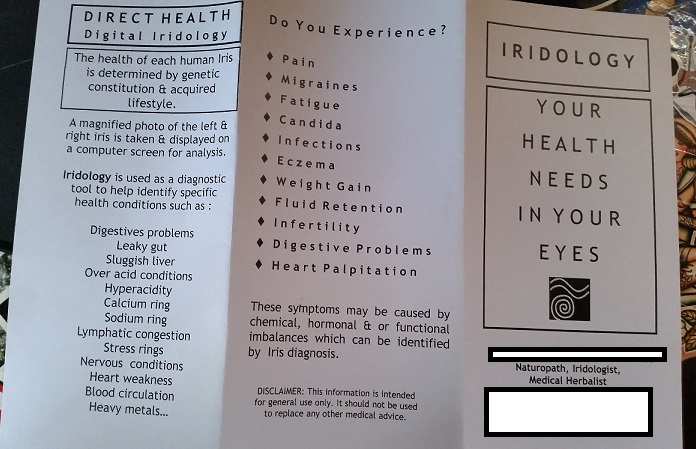
Iris texture is a phenotypical feature meaning the texture of the iris is determined by genetic make-up. Several conditions have symptoms that can be noticed by examining the eye such as Brushfield spots (which is a characteristic of Downs syndrome) or copper rings (Kayser–Fleischer rings) around the eyes in the case of Wilson’s disease. The Kayser–Fleischer rings are copper deposits in the Descemet’s membrane of the cornea and not actual changes to the iris. The iris structure is so stable and unchanging, iris recognition can be used as a form of biometric technology for identification purposes.
STUDIES CONDUCTED:
Several studies have been conducted which have tested the abilities of iridologists. The descriptions of the studies have been replicated from here. The references for the studies can be found at the end of the iridology section of the artilce.
“In 1979 Bernard Jensen and two other proponents failed a scientific test in which they examined photographs of the eyes of 143 persons in an attempt to determine which ones had kidney impairments. (Forty-eight had been diagnosed with a standard kidney function test, and the rest had normal function.) One iridologist, for example, decided that 88% of the normal patients had kidney disease, while another judged that 74% of patients sick enough to need artificial kidney treatment were normal” (Simon, A. 1979).
“In 1980, an experienced Australian iridologist underwent two tests. In the first, he examined photographs of 15 patients who had been medically evaluated and had a total of 33 health problems. The iridologist did not correctly diagnose any of these problems. In three cases he named a part of the body that had had trouble (for example, he said “lesion in throat area” for a patient whose tonsils had been removed during childhood), but he completely missed the other 30 problem areas and made 60 incorrect diagnoses. In the second trial, four people had their eyes photographed when they were in good health and rephotographed when they reported being ill. The iridologist made a large number of (incorrect) diagnoses from the initial photographs and was unable to accurately identify any organ that underwent a change when the health problem arose. He was also asked to compare iris photographs of another healthy individual taken only two minutes apart. He made five incorrect diagnoses for the first of these and four different incorrect ones for the second” (Cockburn DM. 1981).
“In the late 1980s, five leading Dutch iridologists failed a similar test in which they were shown stereo color slides of the right iris of 78 people, half of whom had gallbladder disease. None of the five could distinguish between the patients with gallbladder disease and the people who were healthy. Nor did they agree with each other about which was which” (Knipschild P. 1988).
“In another study, researchers took color photographs of the eyes of 30 patients with ulcerative colitis, 25 with coronary heart disease, 30 with asthma, 30 with psoriasis, and a control group matched for age and gender. The photographs were coded and analyzed by an investigator, both manually and by a computer program according to criteria generated by leading iridologists. Using either method, discrimination between cases and controls was not different from what would be expected by chance. The authors concluded that “diagnosis of these diseases cannot be aided by an iridological-style analysis.” (Buchanan TJ. 1996)
“In 1998, Eugene Emery, a science writer for the Providence Journal, tested the ability of two iridologists to assess his health and to match slide he had prepared of the eyes of eight people who had been medically diagnosed. Both iridologists scored very poorly“. You can find the article here (Emery CE. 1989).
“A study published in 2005 tested whether iridology could be useful in diagnosing common forms of cancer. An experienced practitioner examined the eyes of 68 people who had proven cancers of the breast, ovary, uterus, prostate, or colorectum, and 42 for whom there was no medical evidence of cancer. The practitioner, who was unaware of their gender or medical details, was asked to suggest up to five diagnoses for each person and his results were then compared with each subject’s known medical diagnosis. Iridology correctly diagnosed cancer in only 3 of the 68 cases” (Münstedt K. 2005)).
CONCLUSION:
For iridology to be considered a legitimate form of diagnosis, it would require a complete rewiring of the human body to create a feedback system that delivers diagnostic information specifically to the iris from other parts of the body. Or just a complete and utter dismissal of medical and biological knowledge altogether. Currently there is no known system within the human body that transmits the health status of a person to said persons irises. We’ve been cutting up bodies and accumulating more and more medical knowledge for hundreds of years – you’d think we would have found something by now.
References:
1. Simon A and others. An evaluation of iridology. JAMA 242:1385-1387, 1979
2. Cockburn DM. A study of the validity of iris diagnosis. Australian Journal of Optometry. 64:154-157, 1981
3. Knipschild P. Looking for gall bladder disease in the patient’s iris. British Medical Journal 297:1578-1581, 1988
4. Buchanan TJ and others. An investigation of the relationship between anatomical features in the iris and systematic disease with reference to iridology. Complementary Therapies in Medicine 4:98-102, 1996
5. Emery CE. Iridology: Do the eyes have it? Nutrition Forum 6:5-6, 1989.
6. Münstedt K and others Can iridology detect susceptibility to cancer? A prospective case-controlled study. Journal of Alternative and Complementary Medicine 11;515-519, 2005.
Quack diagnosis is made by: Looking at a person irises really closely.
Conclusion: Complete crap.
REFLEXOLOGY:
Before I start, I feel the need to point out that the suffix “ology” derives from Greek “logos” meaning “the study of“. Iridology is the study of irises. Reflexology is the study of reflexes ( I guess). Having an “ology” attached to the end of something doesn’t actually make it a science or legitimate. Apparently I need to say that in writing because people seemingly have a mighty need to continually make this mistake which makes me sad.
Created in 1913 by William Fitzgerald, Fitzgerald believed that a force field he called “bioelectric energy”, ran through the body in ten vertical bands corresponding to the ten digits of the feet and hands. Reflexologists believe they can manipulate this force field to promote wellness in the body. Reflexology promotes the idea that different areas of the feet and hands correspond to different areas of the body and that massaging specific areas of the feet and hands will treat or cure disease or illness due to the “bioelectric energy” that runs throughout the body.
Much like Iridology, illness and disease are diagnosed using one specific body part. By this logic, my big toes correspond to my clitoris because the way to my heart is not only through my stomach with food but by giving me a foot rub (heavy on the toe action). I’m certain one day I’ll achieve orgasm by having just a foot rub while listening to the Avengers soundtrack and eating Cheezels.
Also like Iridology, Reflexologists use a chart to help in diagnosis:
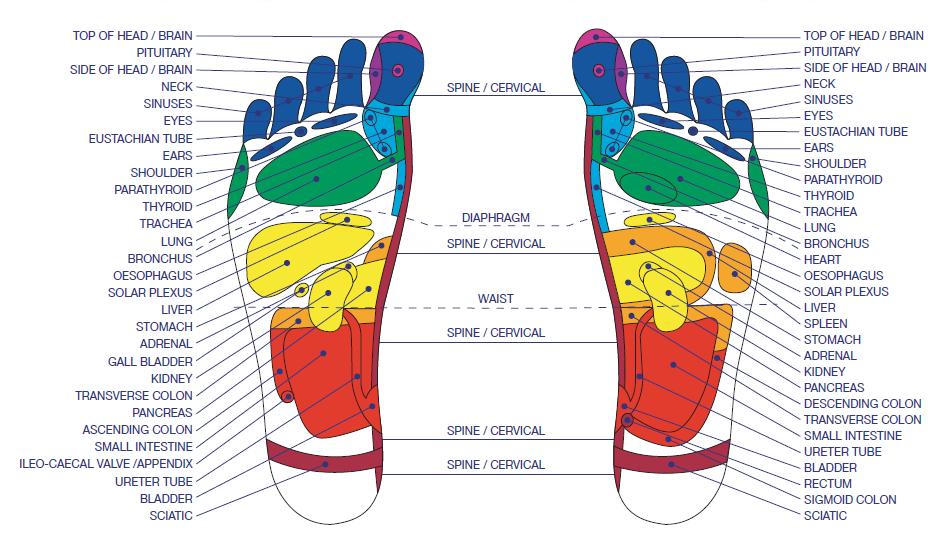
I stood on a rock yesterday in the exact location that corresponds with the rectum – does this mean my arse is going to fall off?
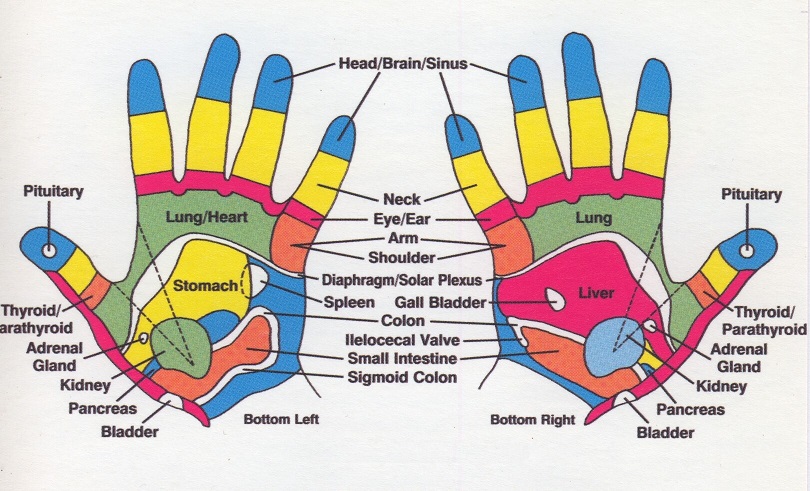
According to the website “Optimum Reflexology” reflexology can treat “Anxiety, arthritis, back pain, chronic illnesses – diabetes, ms, chronic pain ,depression, digestive disorders, fertility, hormonal imbalances, migraine, pregnancy related conditions, preparation for and priming of labour, sinusitis, sleep disorders, sports injuries, stress“. The brochure I picked up at Woofest even goes as far to state that Reflexology can “detoxify the body” and we all know detoxing is a marketing scam.

STUDIES CONDUCTED:
Edzard Ernst (2009) conducted a systematic review of RCT examining reflexology – only to conclude “The best evidence available to date does not demonstrate convincingly that reflexology is an effective treatment for any medical condition“.
A study conducted in the year 2000 (White AR, 2000) found no signification relationship between the patient’s medical diagnoses and the reflexologists’ findings. Three reflexologists examined 18 adults with one or more of six specified conditions which were identified from the participants medical records. Two reflexologists, who were blinded to the patients’ conditions and monitored, then examined each patient’s feet and rated the chance that the six conditions were present – they couldn’t even agree with each other about what conditions were present.
CONCLUSIONS:
Foot rubs are fantastic. They feel good and help people relax and unwind after a hard days work. Reducing stress in one’s life may help with feeling better and may promote a sense of happiness and relaxation however reflexology is not going to treat a sinus infection or sexually transmitted disease. It will just make your feet feel really nice for a bit.
References:
Ernst E (2009). “Is reflexology an effective intervention? A systematic review of randomised controlled trials“. Med J Aust 191 (5): 263–6. PMID 19740047
White AR and others. A blinded investigation into the accuracy of reflexology charts. Complementary Therapies in Medicine 8:166-172, 2000.
Quack diagnosis is made by: Rubbing a persons feet and hands.
Conclusion: Complete crap.
This is the pseudoscience that gets the most apologists defending it. Mainly because when someone massages your back when it’s in pain – it feels good. This somehow translates into “Chiropractic works”.
Chiropractic was invented by Daniel David Palmer, a grocer who claimed to have restored a deaf man’s hearing by “adjusting” a bump in the man’s spine. Palmer concluded that misaligned bones (“subluxations”) interfered with the body’s expression of “Innate Intelligence” which is the description given by chiropractors for the body’s ability to heal itself. According to chiropractic, misaligned bones in your spine fuck up the body’s ability to heal from illnesses which one can assume includes sinus infections. The treatment used by chiropractors is called an “adjustment” which is a specialised “thrust” of the hand one the misaligned bone to realign it. Chiropractors mainly work with the spine and neck.
Chiropractors tend to disagree whether chiropractic sublaxations can be seen visually on an x-ray – some believe they can feel misaligned bones by touch. The difference between a chiropractor sublaxation and a medical sublaxation is pretty clear. A chiropractic sublaxation is a misalignment of a bone that interrupts the body’s ability to heal itself which is thought to cause disease or illness. A medical sublaxation (orthopedic subluxation) is a partial dislocation of a joint or vertebrae commonly caused by disc degeneration, curvatures, spondylolysis, and structural abnormalities of the spine (source).
Chiropractors largely disagree on the idea of whether chiropractic sublaxations exist and can treat illness. Some reject the idea and stick to “adjusting” the spines of people with large wallets to treat back pain only – some fully believe that pushing your spine a little to the right or left can treat a disease. Perhaps what is even more disturbing is chiropractors who “adjust” children. Chiropractic paediatric websites claim that an “adjustment” can “help many potentially serious childhood conditions including, fever, colic, croup, allergies, wheezing, poor posture, stomachache, hearing loss, headaches, asthma, bedwetting, bronchitis, learning disorders, arthritis and attention deficit hyperactivity disorder, among other things”.
STUDIES CONDUCTED:
In 2009, Science Based Medicine examined Chiropractic, particularly the studies around the legitimacy of the profession:
In “An epidemiological examination of the subluxation construct using Hill’s criteria of causation” Timothy A. Mirtz, Lon Morgan, Lawrence H. Wyatt, and Leon Greene analyze the peer-reviewed chiropractic literature in the light of Hill’s criteria, the most commonly used model for evaluating whether a suspected cause is a real cause. They ask whether the evidence shows that chiropractic subluxations cause interference with the nervous system and whether they cause disease. The evidence fails to fulfill even a single one of Hill’s nine criteria of causation.
They conclude: There is a significant lack of evidence in the literature to fulfill Hill’s criteria of causation as regards chiropractic subluxation. No supportive evidence is found for the chiropractic subluxation being associated with any disease process or of creating suboptimal health conditions requiring intervention. Regardless of popular appeal this leaves the subluxation construct in the realm of unsupported speculation. This lack of supportive evidence suggests the subluxation construct has no valid clinical applicability. [emphasis added]
In two recent studies cited in the Mirtz et al. article, 98% of chiropractors believed that “most” or “many” diseases were caused by spinal misalignments and over 75% of chiropractors believed that subluxation was a significant contributing factor to 50% or more of visceral disorders (such as asthma and colic).
There is a splatter of evidence that suggests manipulation of the spine can relive back pain. Considering the cost of chiropractic services, one could treat themselves to a back massage and an ice cream after for far less.
CONCLUSIONS:
Chiropractic is pseudoscience with the potential to elicit a placebo effect for people experiencing back pain. Much like homoeopathy – just because you feel a little better after “treatment” doesn’t actually mean the treatment is working or can work the way the treatment is described to work. Sam Homola is a former chiropractor who has written numerous articles and books debunking the idea behind chiropractic. They use the spine as an all-encompassing diagnostic tool – feeling run down? Misaligned spine. Feeling anxious? Misaligned spine. Chiropractic sublaxations have never been shown to exist meaning the diagnostic tool is one purely based on a grocers idea of how the spine affects the body.
I dismiss chiropractic because while it may elicit a placebo effect for people and spinal manipulation can help with back pain – a physiotherapist can do the same thing. I wouldn’t touch a chiropractor with a ten foot pole for anything relating to my neck – neck adjustments have been linked to strokes. As for the idea that aligned bumps in my spine can treat illnesses? I’ll talk a less costly placebo.
Quack diagnosis is made by: The underpinning framework of the profession is that illness is caused by misaligned bones particularly in the spine therefore this is the cause of all illness. In short, the spine is the cause of all evil.
Conclusion: Complete crap.
All three of the above alternative medicines are essentially the same – they claim to diagnose and treat illness but in separate ways. All three focus on a specific body part either as the medium to treat an illness or disease or as the cause of illness and disease. The tool for iridology is the eyes – the treatment usually supplement based, the tool for reflexology is the feet and hands – the treatment being a massage. The root of all evil for chiropractors is misaligned vertebrae – the treatment being “adjustments”.
All three alternative medicines can elicit a placebo effect for the person being treated, especially one who doesn’t understand biology. As I’ve mentioned before, the placebo effect isn’t inherently a bad thing however using unproven treatments and not real medicine for illnesses and disease that actually need medication or proper medical treatment is dangerous. Alternative medicine practitioners have a nasty habit of lying about medicine that works in order to just more customers through their door.
Plenty of apologists will say we shouldn’t dismiss treatments that make people feel better but I disagree. These treatments are only bringing the illusion that people are more healthy because of them, these treatments aren’t actually treating illness or disease. The above treatments are nothing more than a glorified sugar pill. Iridologists and reflexologists can’t even diagnose illness accurately meaning the chances of going to an iridologist or reflexologist and coming away with an unproven treatment for an illness you may not even have is a possibility.
The above alternative medicine (indeed altmed in general) shouldn’t be given any legitimacy as medicine when all they do is create the same feeling as foot massage by the way of pseudoscientific bullshit and lies aimed at scientifically illiterate people. Foot massages are great and they can make people relaxed and less stressed – that’s what the placebo effect does. I can get a foot massage at home. For free. From a naked woman who brings me food.
I win.
For more in the Woo and Lament series, check out
Woofest 2014: The Beginning.
Woofest 2014: Episode 2: Quack diagnosis
Woofest 2014: Episode 3: Psychics playing the “Mystery Card”
Woofest 2014: Episode 4: A story in tweets
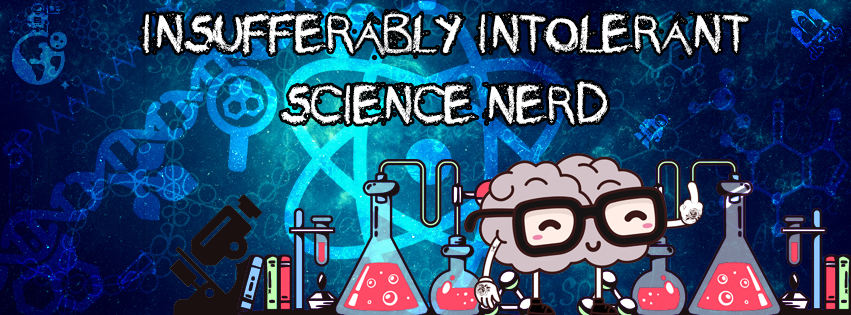




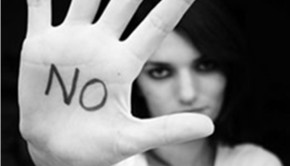


Pingback: » Woo and Lament: Woofest 2014: Episode 4: A story in tweets
Pingback: » Food Babe: A different kind of smart
Pingback: » Woo and Lament Series: Woofest 2014 – Episode 3: Psychics playing the “Mystery Card”
Pingback: » Woo and Lament Series: Woofest 2014 – Episode 1: The Beginning